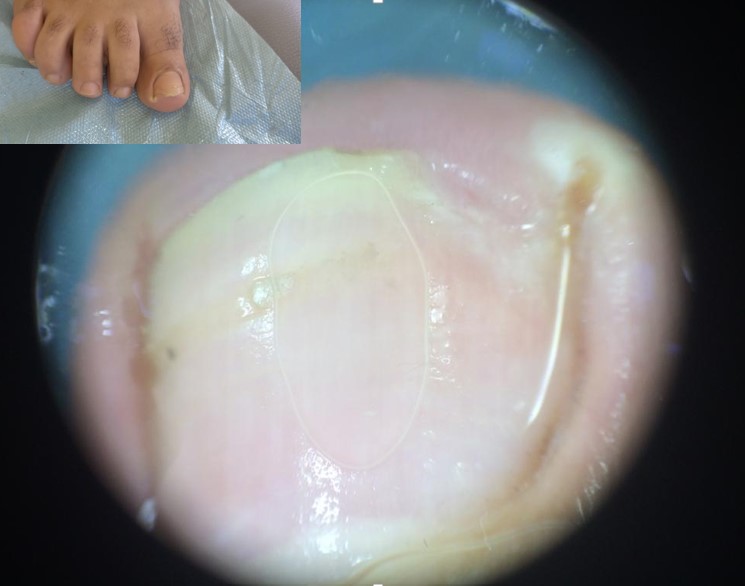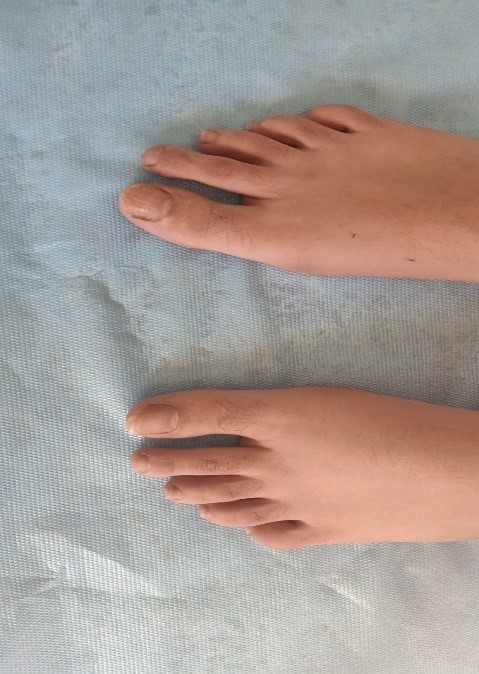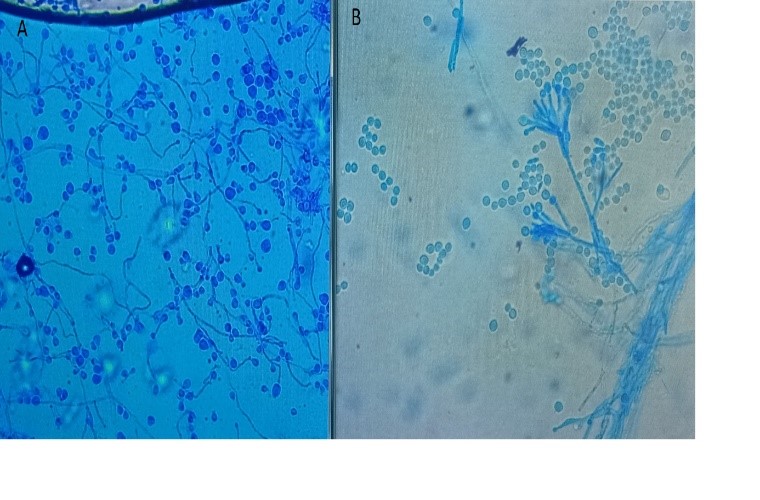Indexing & Abstracting
Full Text
Case ReportDOI Number : 10.36811/jcri.2020.110016Article Views : 6Article Downloads : 6
Molds involving toenails: about two case reports
Khadija Elboukhari1,*, Asmae Rasso1, Sara Elloudi1, Zakia Douhi1, Hanane Baybay1, Fatima Zahra Mernissi1, Asmae Krich2, Fatima Zahra Hamdi2 and Zineb Tlamçani2
1Department of Dermatology, University Hospital of Fez, Morocco
2Department of Mycology, University Hospital of Fez, Morocco
*Corresponding Author: Khadija Elboukhari, Department of Dermatology, University Hospital of Fez, Morocco, Email: elboukharikhadija89@gmail.com
Article Information
Aritcle Type: Case Report
Citation: Khadija Elboukhari, Asmae Rasso, Sara Elloudi, et al. 2020. Molds involving toenails: about two case reports. J Case Rept Img. 2: 12-14.
Copyright: This is an open-access article distributed under the terms of the Creative Commons Attribution License, which permits unrestricted use, distribution, and reproduction in any medium, provided the original author and source are credited. Copyright © 2020; Khadija Elboukhari
Publication history:
Received date: 09 March, 2020Accepted date: 16 March, 2020
Published date: 17 March, 2020
Abstract
Onychomycosis is usually caused by dermatophytes, yeasts and molds are less frequently, associated to nail invasion. Molds have been increasingly recognized as causative agents of onychomycosis. We report two cases of young immunocompetent women who consulted in our department with ungueal abnormalities. We found Scopulariopsis brevicaulis, a cosmopolitan molds, in their toenails after a repetitive mycological examination.
Keywords: Molds; Scapularosis is brevicaulis; Onychomycosis
Introduction
Scapularosis brevicaulis is a filamentous fungus, which can be responsible for nondermatophyte onychomycosis. This cosmopolitan mold is frequently encountered in the soil and is rarely responsible for nail invasion, however, Its prevalence among onychomycosis is increasing these last years. Many clinical appearances are described with this mycological affection.
Case report
A 38 years old woman, with a history of lateral nail incarnation, consulted for a painful lesion of the nail. The dermatological examination with dermoscopy noted distal and lateral onycholysis with beau’s Line of the first right toenail, without subungual hyperkeratosis (Figure 1). 24 years old, consulted with our department with a history of toenail discoloration for two years. The dermatological examination noted diffuse nail dystrophy with trachyonichia (Figure 2). We conducted for both patients, mycological specimens with and culture test showing numerous branched conidiophores with chains of lemon-shaped conidia (Figure 3). Our patients have already benefited from a biological assessment that was correct. The treatment by terbinafine was conducted and it still in process.

Figure 1: Distal and lateral onycholyse with beau’s Line.

Figure 2: A diffuse nail dystrophy with trachyonichia.

Figure 3: Stain ×400 .Slide culture of Scopulariopsis brevicaulis showing chains of lemon-shaped conidia identified in bothe of our patients (A and B).
Discussion
Scopulariopsis brevicaulis is a non-dermatophyte fungus which is considered having saprophytic or opportunistic comportment. It is responsible for 1-10% of nail non-dermatophyte onychomycosis [1]. In Morocco, the prevalence of Onychomycosis with mold varied between 1 and 3% [2,3]. (12,7 %) of identified mold are S. brevicaulis [2]. Among molds and yeasts, the genus Scopulariopsis (S. brevicaulis, S. acremonium, S. brumptii S. fusca, and S. koningii) are saprophytes found in soil worldwide [4], responsible of about 1.45~17.6% of onychomycosis [5]. In Human Body, S. brevicaulis is responsible for nail invasion in most cases, more rarely it can be responsible for profound infections, endocarditis or endophthalmitis in the occasion of trauma, surgery or immunocompromised patients [6,7]. The clinical presentation of nail affection is classically a distolateral subungual onychomycosis (DLSO), while other aspects are reported such are proximal subungual onychomycosis (PSO) [8-10], superficial white onychomycosis (SWO), total dystrophic onychomycosis [2], and endonym onychomycosis [11,12].
A direct microscopic examination does not always result in positive in NDM onychomycosis; therefore to perform a correct diagnosis, a proper mycological culture is often required. The diagnosis requires repetitive isolation of the fungus by culture) [8,12]. The management of this non-dermatophyte onychomycosis may be difficult and require often the association of mechanical to the antimycotic agents [2]. Terbinafine and itraconazole may be an effective treatment of this onychomycosis, this is not the case for griseofulvin [13].
Conclusion
Onychomycosis caused by Scapularosis brevicaulis have a variant prevalence in the wild word, the laboratory implication is fundamental to identify of this affection, and ameliorate the diagnosis and management of molds onychomycosis.
References
1. Tosti A, Piraccini BM, Lorenzi S. 2000. Onychomycosis caused by nondermatophytic molds: clinical features and response to treatment of 59 cases. J Am Acad Dermatol. 42: 217-224. Ref. : https://www.ncbi.nlm.nih.gov/pubmed/10642676
2. Hajoui FZM, Zeroual Z, Ghfir B, et al. 2012. The mould onychomycosis in Morocco: about 150 isolated cases in 20 years. 22 : 221-224. Ref. : https://www.ncbi.nlm.nih.gov/pubmed/23518078
3. Boukachabine K, Agoumi A, 2005. [Onychomycosis in Morocco: experience of the parasitology and medical mycology laboratory from Rabat children hospital (1982-2003)]. Ann Biol Clin (Paris). 63: 639-642. Ref.: https://www.ncbi.nlm.nih.gov/pubmed/16330383
4. Kwon-Chung KJ, Bennett JE. 1992. In: Medical mycology. Philadelphia: Lea & Febiger. 752-755.
5. Moreno G, Arenas R. 2010. Other fungi causing onychomycosis. Clin Dermatol. 28: 160-163. Ref.: https://www.ncbi.nlm.nih.gov/pubmed/20347658
6. Oh BJ, Chae MJ, Cho D, et al. 2006. Infection with Scopulariopsis brevicaulis after Cosmetic Surgery of the Face. Korean J Lab Med. 26: 32-35. Ref.: https://www.ncbi.nlm.nih.gov/pubmed/18156696
7. Lee MH, Hwang SM, Suh MK, et al. 2012. Onychomycosis Caused by Scopulariopsis brevicaulis: Report of Two Cases. Annals of Dermatology. 24 : 209-213. Ref.: https://www.ncbi.nlm.nih.gov/pubmed/22577275
8. Gupta AK, Drummond-Main C, Cooper EA, et al. 2012. Systematic review of nondermatophyte mold onychomycosis:
Diagnosis, clinical types, epidemiology, and treatment. Journal of the American Academy of Dermatology. 66: 494-502. Ref.: https://www.ncbi.nlm.nih.gov/pubmed/21820203
9. Kim SC, Chon TH, Kim HU. 2000. Onychomycosis due to Scopulariopsis brevicaulis. Korean J Dermatol. 38: 1566-1568.
10. Kim YJ, Lim SW, Suh MK, et al. 2001. Four cases of toenail onychomycosis caused by Scopulariopsis brevicaulis. Korean J Med Mycol. 6: 97-103.
11. Baran R, Hay RJ, Tosti A, et al. 1998. A new classification ofonychomycosis. Br J Dermatol. 139: 567-571.
12. Gupta AK, Drummond-Main C, Cooper EA, et al, 2012. Systematic review of nondermatophyte mold onychomycosis: Diagnosis, clinical types, epidemiology, and treatment. Journal of the American Academy of Dermatology. 66: 494-502. Ref.: https://www.ncbi.nlm.nih.gov/pubmed/21820203
13. Gupta AK, Gregurek-Novak T. 2001. Efficacy of Itraconazole, Terbinafine, Fluconazole, Griseofulvin and Ketoconazole in the Treatment of Scopulariopsis brevicaulis Causing Onychomycosis of the Toes. Dermatology. 202: 235-238. Ref.: https://www.ncbi.nlm.nih.gov/pubmed/11385230




















